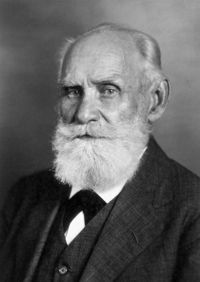Pawlow vs. Potemkin
- Topic
- Building // Coming home
- Date
- 20.08.2020
On Pavlovian Reflexes and Potemkin Villages: How the buildings at Mariahilfer Straße 166 & 168 will become the Vienna Urban Oasis.
In 1904, Ivan Petrovich Pavlov was awarded the Nobel Prize for Medicine for his experiments, the best known probably being the one with dogs, named after him: If you ring a bell every time a dog is fed, over time the dog will begin to salivate each time it hears the ringing of a bell. This Pavlovian response, a classical conditioning, can be proven in experiments and observed in everyday life.


Acoustic, olfactory, and visual stimuli trigger clear expectations. Take, for example, the façade of a historical building. Many people—passersby, tourists, or idlers—expect, almost like a reflex, that behind the façade lie stone stairs, opulent stucco, brass fittings, suites of rooms with high ceilings, salons with double doors, crystal chandeliers, and creaking herringbone floors beneath heavy carpets. When lovingly renovated and adapted to modern lifestyles, these houses are true jewels with an unrivalled quality of life. Anyone who knows our Kremplhof in Leoben, the jewels on Hadikgasse and Herbststraße in Vienna, or our new project on Premlechnergasse will have such expectations confirmed.
Two Russians explain
appearance and reality
But Pavlov’s dogs salivate even when the bell rings and no food arrives. If a house does not fulfil the expectations created by the façade, we are reminded of a second Russian: Field Marshal Gregor Alexandrovich Potemkin. The Potemkin villages named after him were staged to give Empress Catherine the Great the impression of newly established, prosperous rural settlements with pristine scenery. Although historians are divided on the truth of this, the villages have come to symbolize false pretenses. According to Wikipedia, Potemkin villages are used as a term for any “construction (literal or figurative) whose sole purpose is to provide an external façade to [that] which is faring poorly.” Potemkin villages seem elaborate and impressive yet lack substance.
If houses were cars …
The two buildings we purchased at Mariahilfer Straße 166 & 168 fall into just this category. Even the façade elements are retrofitted decorations, not Biedermeier originals. Toilets in the hallway, a dearth of bathrooms, kitchens with a shower instead of a front room, outdated oil heating systems, a concrete courtyard, mold on many of the walls, and damp cellars. The electrical and water installations are particularly “historical”. One can only dream of an elevator or any sort of barrier-free accessibility. “Substandard” is definitely how many of these apartments must be categorized. Life in these buildings was no longer worth living. And that’s not our judgment; those are the words of the tenants themselves! If the houses were cars, they’d be written off as a total loss, the cost of repair exceeding the overall value.
Away with the deceptive decor …
We bought the two buildings anyway. Were we tricked? No, not at all. Did we trick ourselves? No, not that either. We were aware right from the start that the underlying substance and quality of life in the two buildings were highly questionable. And so we planned for two scenarios. One of them was driven by the hope of being able to create a jewel like the ones mentioned above. That was in 2015/16. Two years later, we tackled the second scenario: a complete reboot. So we can hardly be accused of rushing into things. A lot has happened since then. Enumerating all the details goes beyond the scope of this article, but you can read all about it in chronological order here.
… and reintroduce quality of life
So we’re building a new building. Something that it won’t have is façades, which some may miss. We miss them, too. However, some of the things that disappear along with the façades are the damp cellars, moldy walls, hallway toilets, and generally dismal living conditions.
What will be taking their place in Vienna Urban Oasis are 50 bright, modern apartments in several different sizes, with high technical standards and many amenities: elevators; underground parking; moisture-free storage, stroller, and garbage rooms; bicycle parking; a youth playroom; outdoor spaces; a playground in the lushly greened courtyard; and, of course, barrier-free access everywhere. Shop spaces on the ground floor ensure easy access to local supplies. And how will these differences feel? Just ask the tenants who moved from the Mariahilfer Straße 166 & 168 buildings into already finished AVORIS apartments.
One thing that will stay the same, however, is our willingness to talk to everybody who has an opinion on the project and wants to be heard.





















